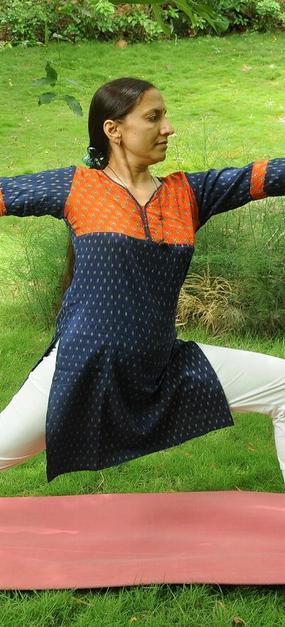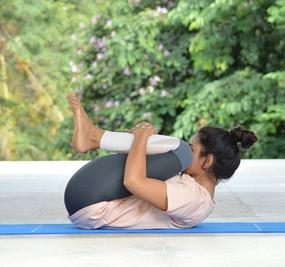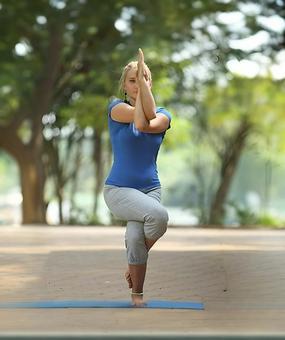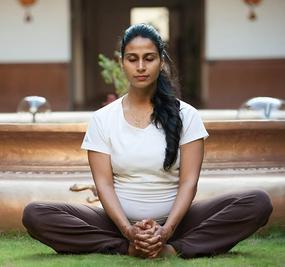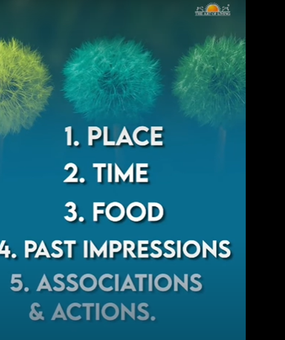Vriksha – Tree; Asana – Posture or Pose
The asana is pronounced as vrik-shah-sa-na
The Sanskrit word”vriksha” means tree. Standing straight on the left leg, bend the right leg and place the right foot on the root of the left thigh. Stand thus like a tree on the ground. This is called “vriksha-asana.”
How to do Vrikshasana?
- Stand with the feet together and the arms by your sides (see the tad-asana).
- Bend the right leg at the knee, raise the right thigh and bring the sole of the right foot as high up the inside of the left thigh as possible.
- Balancing on the left foot, raise both arms over the head keeping the elbows unbent and joining the palms together. Hold the posture while breathing gently through the nostrils for about 10 complete breaths.
- Lower the arms and right leg and return to the tad-asana, standing position with feet together and arms at the sides. Pause for a few moments and repeat on the opposite leg.
Benefits
- This pose leaves you in a state of rejuvenation. It stretches the legs, back and arms, and invigorates you.
- It brings balance and equilibrium to your mind.
- It helps improve concentration.
- This posture has been found to relieve some cases of sciatica.
- It makes the legs strong, improves balance, and opens the hips.
- Helps those who are suffering from sciatica.
Contraindications
Avoid doing this posture if you are suffering from migraine, insomnia, low or high blood pressure (those with high blood pressure may do this pose but without raising their hands overhead, as this may further raise their blood pressure).
View All – Standing Yoga Asanas
All Yoga PosesPrevious yoga pose: Prasarita Padahastasana
Next yoga pose: Paschim Namaskarasana
FAQ’s on Vrikshasana (Tree Pose)
Practice Vrikshasana for the duration you are comfortable with. Hold the asana for up to 1 minute on each leg. You can repeat five times on each leg.
Avoid Vrikshasana if you suffer from migraine, insomnia, dizziness, knee or ankle pain and low or high blood pressure. Raising your hands above your head raises your blood pressure. Thus, people who have high blood pressure should avoid raising their hands. They can balance their body on each leg.
Dos of Vrikshasana: Look straight ahead in front of you, at a distant object. A steady gaze helps maintain a balance. Stand tall and straight with arms by the side of your body. Bend your right knee and place the right foot high up on your left thigh. You can use your hand to place the foot. The sole should be placed flat and firmly near the root of the thigh. Make sure that your left leg is straight. Find your balance. The foot presses against the thigh and the thigh against the foot. Once you are well balanced, take a deep breath in, gracefully raise your arms over your head from the side, and bring your palms together in ‘Namaste’ mudra (hands-folded position). Keep stretching your body in the upward direction. Ensure that your spine is straight. Your entire body should be like a stretched elastic band. Keep taking in long deep breaths. With each exhalation, relax the body more and more. Just be with the body and the breath wearing a gentle smile on your face. With slow exhalation, gently bring down your hands from the sides. You may gently release the right leg. Stand tall and straight as you did at the beginning of the posture. Repeat this pose with the left leg off the ground on the right thigh. Practice Vrikshasana for the duration you are comfortable with. Hold the asana for up to 1 minute on each leg. You can repeat up to 5 times on each leg.
Don’ts of Vrikshasana: Avoid if you suffer from migraine, insomnia, dizziness, knee or ankle pain and low or high blood pressure. Raising your hands above your head raises your blood pressure. Thus, people who have high blood pressure should avoid raising their hands. They can balance their body on each leg.
Don’ts of Vrikshasana: Avoid if you suffer from migraine, insomnia, dizziness, knee or ankle pain and low or high blood pressure. Raising your hands above your head raises your blood pressure. Thus, people who have high blood pressure should avoid raising their hands. They can balance their body on each leg.
People have benefited from Vrikshasana to increase height. It stretches the legs making them strong. On balancing the weight of the body on one leg, the leg muscles are strengthened. On extending your hands above head, your neck is also pulled upward. This activates the pituitary glands which produces the growth hormone.
Genetics, lifestyle factors, yoga, exercise and nutrition are some of the factors that influence your height. After 25 years of age, height does not increase anymore. You can only follow ways to look taller. As you age due to drooping shoulders and back, your height seems to be decreasing. The decrease in height can be prevented by practicing yoga asanas.
Spine, hips, knees, ankle and arms are flexed. The hips turn outward and open up. The ankle is bent backward and contracted.
Precautions of Vrikshasana: *Migraine *High or low blood pressure (those with high blood pressure may do Tree Pose but without raising the arms above the head, as doing so may further raise blood pressure) *Insomnia.



